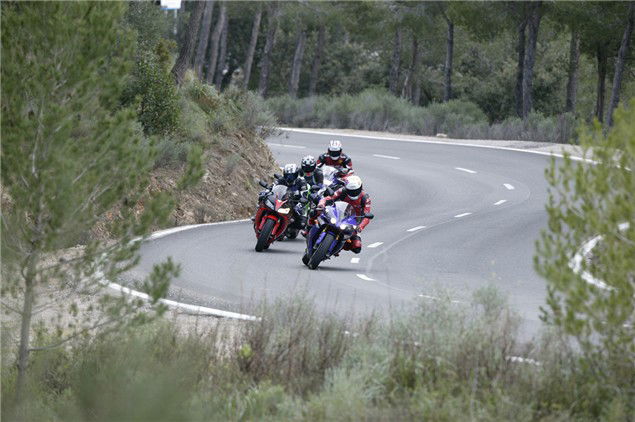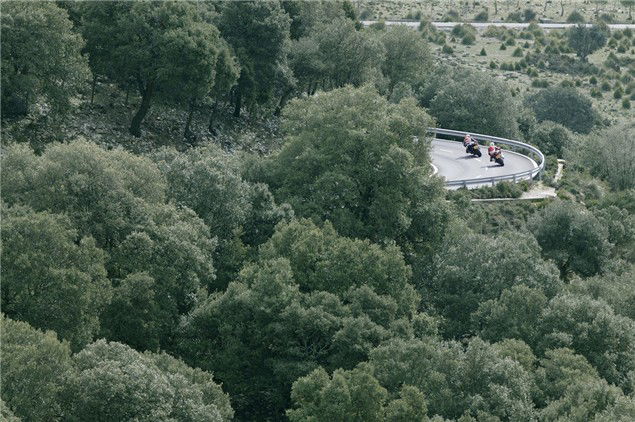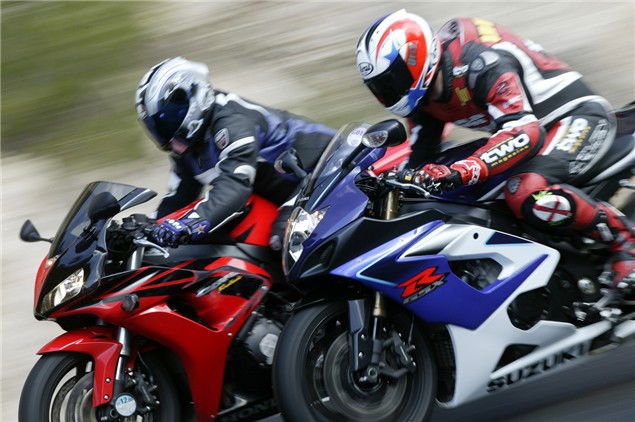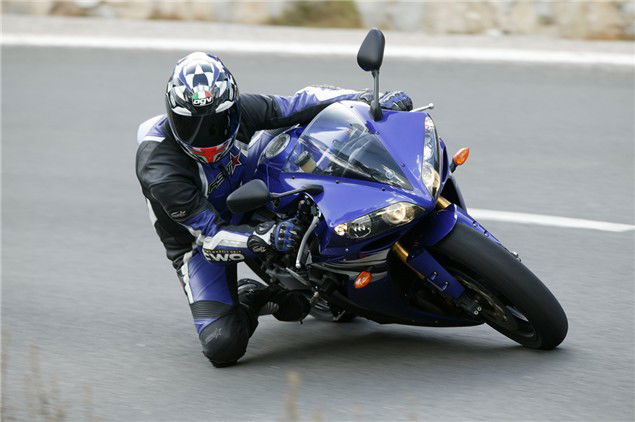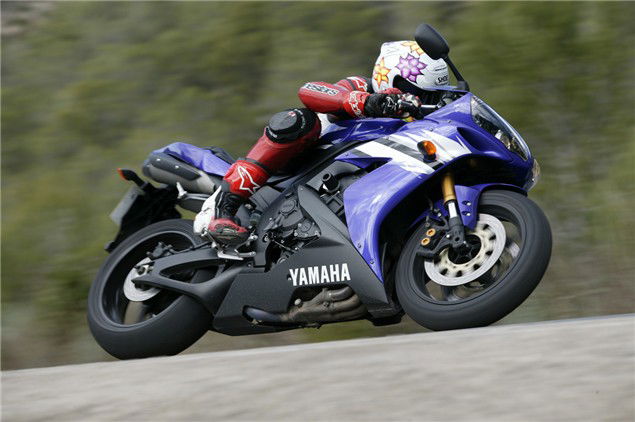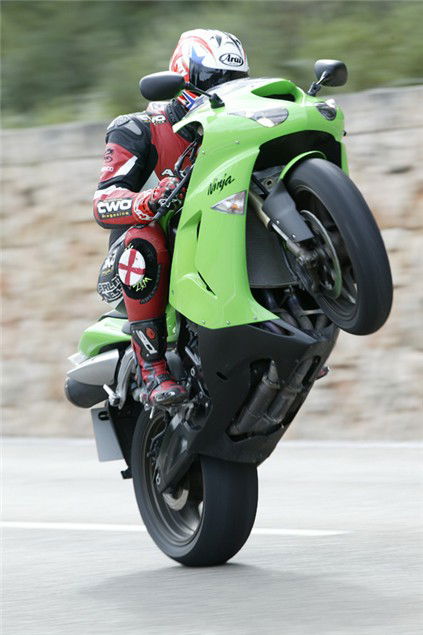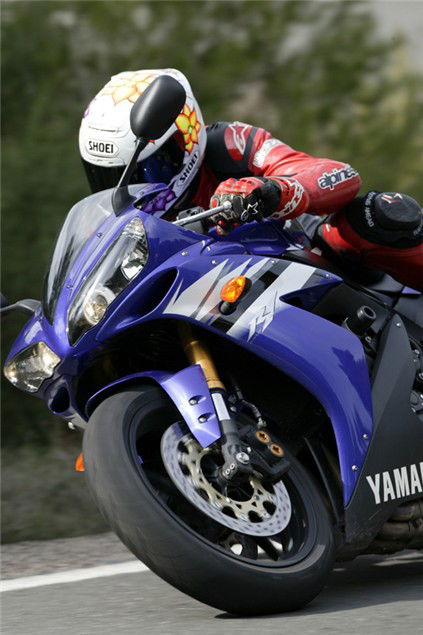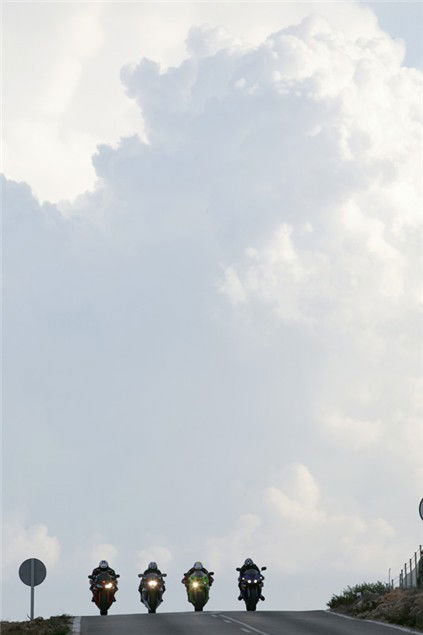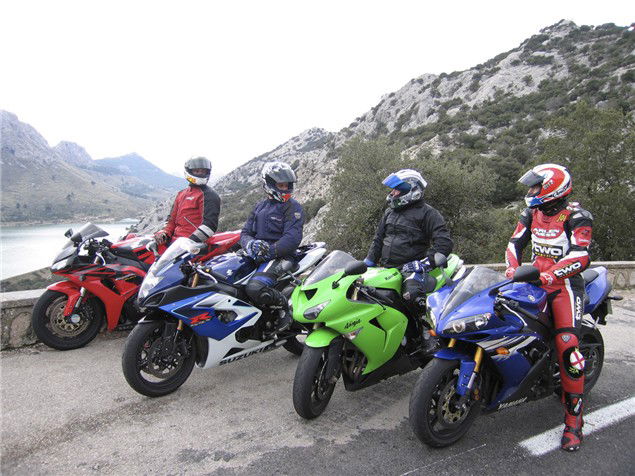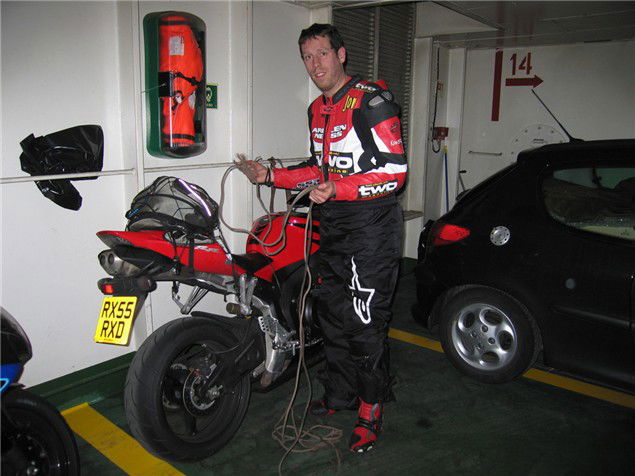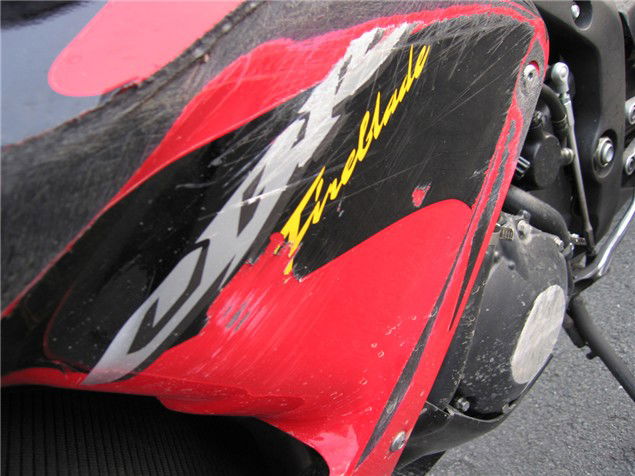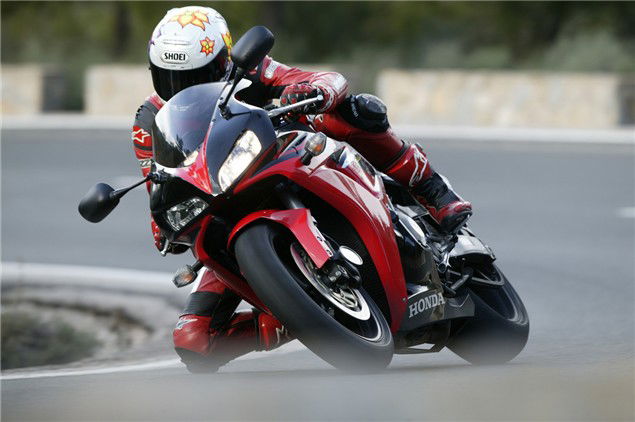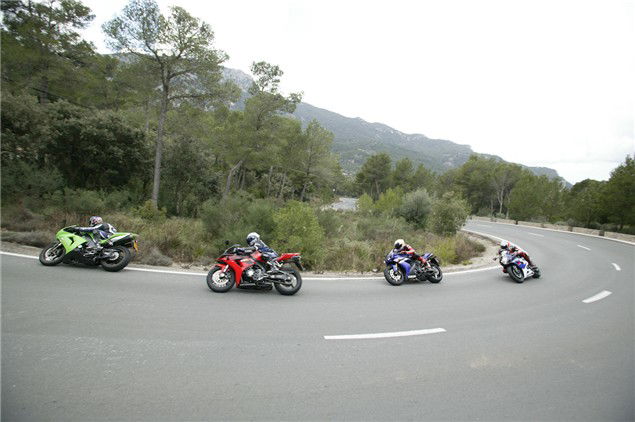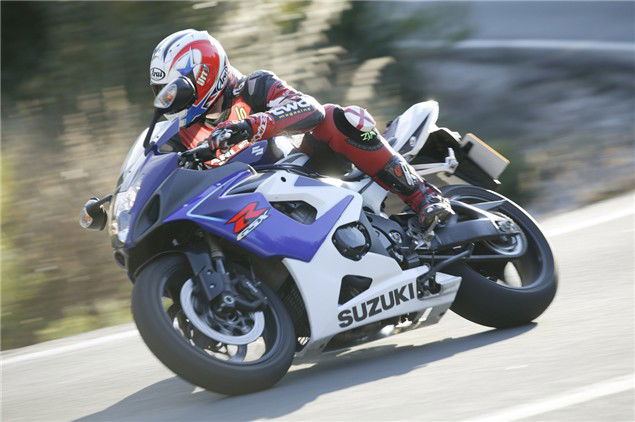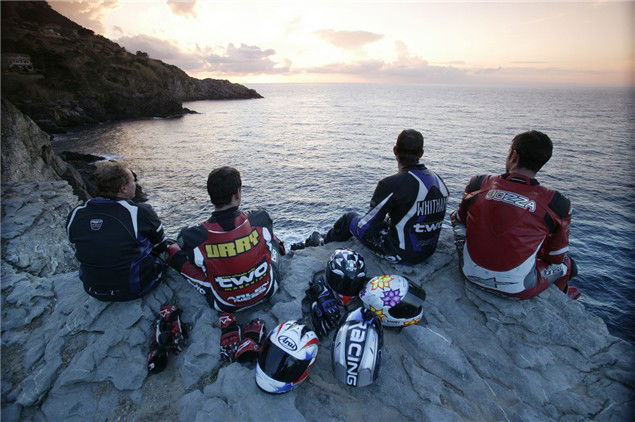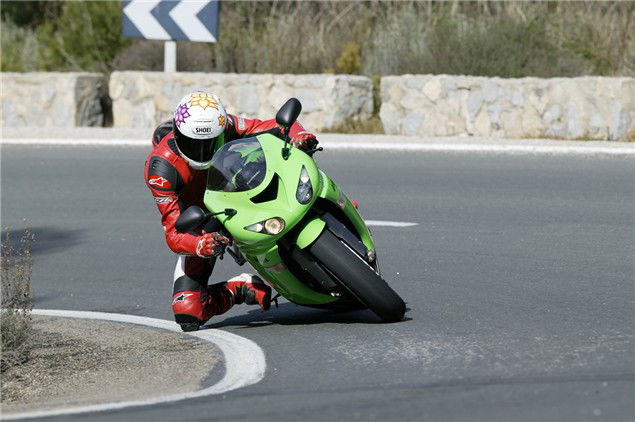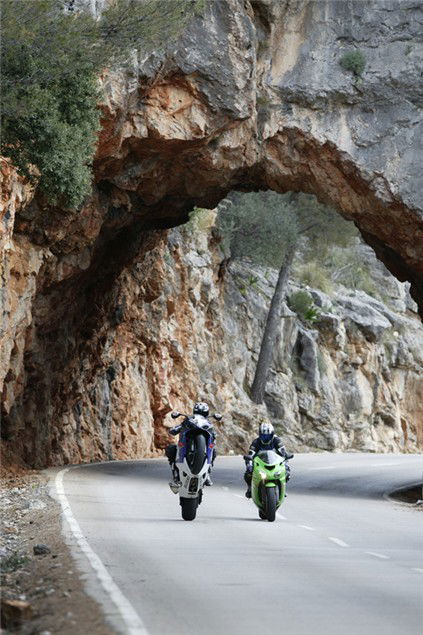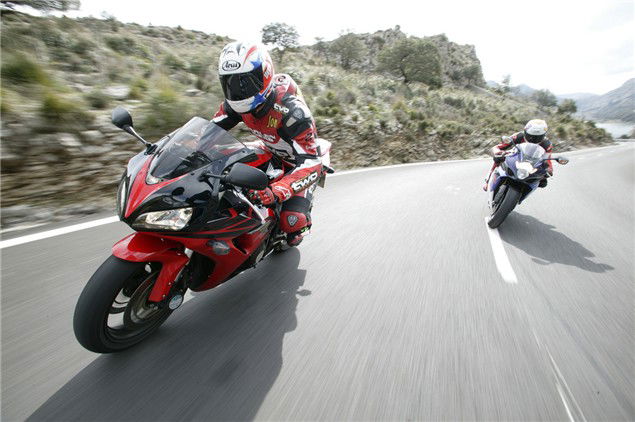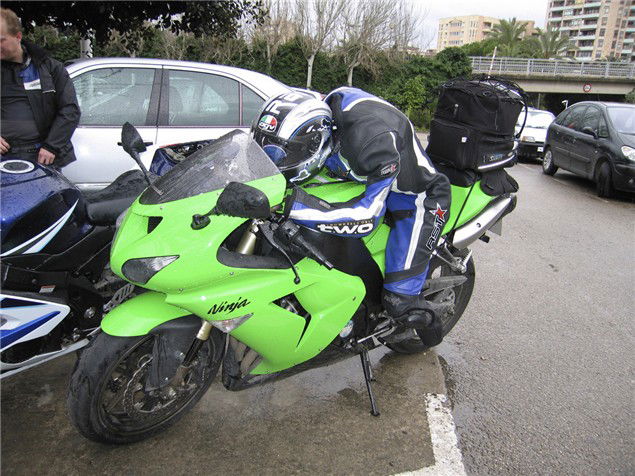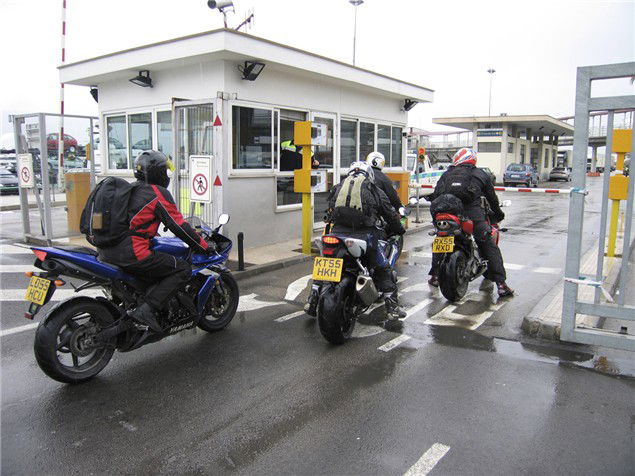Road Test: CBR1000RR v ZX-10R v GSX-R1000K6 v R1
1000cc sports bikes go ballistic to Majorca. Does the water taste like what it oughta?

The French copper is looking confused. "Accident?" It's more of a question than a statement. His bemused gaze passes over the four brand new-looking bikes parked in front of a petrol pump. "There has been a crash?" Some fast-fingered motorist has obviously got on the blower and reported a bike sliding down the fast lane of the motorway. Our rozzer must have hurried to the scene expecting to find a tangled heap of metal.
Keen to avoid an extended interview with the authorities, I try to confuse him with a spot of bad French.
"No, non problem, Monsieur," I try, while still smiling, "C'est okay, bon." He seems pacified, if still a little baffled, and slips his blue and white Peugeot into gear and prepares to pull away.
Unfortunately it's at this point he spots the elbow of my jacket is worn away and the red leather suit underneath is poking out. "You crash," he says. Definitely a statement now, not a question. "Yes," I say, "but only very slow, no problem," adding another nervous smile and a quick thumbs up for good measure. He may not be entirely satisifed but he scoots off anyway, no doubt reluctant to leave the warm and dry sanctuary of his car.
Only 400 miles or so into our mini-epic trip to Majorca and I've thrown a brand new Fireblade down the road. A schoolboy braking error on a very wet motorway locked the front wheel, precipitating a long and graceless slide. Considering the, um, speed at which all this occured - or at least began - the Fireblade came out well. When James Whitham himself describes your crash as 'spectacular' you know you've had a big one, but the Honda limped away with nothing more than minor scratches, a missing bar end and a neatly polished engine case (thanks to the Emery paper-like effect of water and Tarmac ). No holes, not even a bent bar, and still rideable. While at this point its mega sharp front brake wasn't high on my list of likes about the Honda, the rest of it was really growing on me.
Even before we'd left the office the Honda had scored. Tail pack in hand I'd approached first the R1, then the GSX-R1000... not a chance of securing it to either (although somehow Tim managed it with his GSX-R1000 last year), so I tried the Blade. Bungee points and fantastic pillion pegs with cut-outs for bungee hooks made it easy. Top marks, Honda - practicality in a sportsbike, what next?
So off, then, to Majorca, where the roads are ace (according to James), the weather is good (according to the BBC), and off-season hotels are cheap ("They'd better be, or else," according to Grant). With the latest 1000cc sports tools at our disposal we'd be wasting our time in Blighty. It was easy to arrange a team: Whitham and his superstock racer mate Shoey were bang up for it. Tim was keen but dropped out at the last minute because he'd got a date, thus the multi-talented Warren Pole was persuaded to take a break from his voiceover work on Channel Five's Sex Lives of the Japanese.
Our plan involved a 600-mile London-to-Lyon slog on the first day. Should have been easy; thanks to rain and fuel range it wasn't.
Tim's got a measured approach to touring on sportsbikes that involves holding a steady speed and maximising every tank full. It's the stopping that kills your average speed, you see. Unfortunately Wozza, who we'd foolishly allowed to take the leadership mantle, has yet to grasp any part of this elementary concept.
"You're screwed," was Tim's gnomic verdict before we even set off. "Wozza rides like a complete twat. Don't let him lead."
As we discovered, Wozza's approach (summary: "You might as well enjoy the ride, so go really fast") doesn't hold up when you're cold, wet, 200 miles from where you want to be and stopping every 85 miles because you're burning fuel faster than an ACME jet pack.
Still, you learn things about the bikes; that they'll only do around 95 miles until reserve, even at a gentle(ish) pace, and that while none of them have fuel gauges, only the Yamaha has a genuinely useful fuel trip as well as a reserve light. The 2006 ZX-10R's new style instruments - digital speedo and analogue rev counter - are far clearer than the old all-digital set-up, but the flashing 'fuel' warning is just plain silly. You can see the fuel light's on, but because the trip display is taken up by the word 'fuel' you've no idea how far you've gone on reserve. Of course, on sportsbikes every kilo makes a difference, but since most of them will primarily be used on the road rather than on track, the longer-term practicality of having proper fuel gauges as standard would be worth the extra weight.
People say that you can't tour on sportsbikes, which is, quite frankly, utter twaddle. You can tour on any bike, it's just down to how much fun you have while doing it. The Lyon leg of our trip had been a nightmare. With only 450 miles to go and a dry dawn after a night's sleep (notwithstanding the faintly pissy waft of Lyon, somewhere between a tramp's pants and a Yeti's cock) even the regular fuel stops were something to look forward to.
"Yesterday I was wondering why the hell I was doing this," said James, "but this is mint. It's the first time I've done a big miles trip on sportsbikes and I'm loving it. Usually I ride them on track, which gives you one impression, but this really makes you think about the bikes. Before I wouldn't have recommended any of these for distance, but they're really good and even fairly comfortable."
Despite their sporting pedigree these bikes aren't uncomfortable over a distance. There were individual preferences: taller riders (that's myself and Wozza, both over six feet) liked the extra roominess of the Fireblade and ZX-10R while the 'vertically challenged' James and Shoey preferred the R1 and GSX-R1000.
"The seat is too big on the Kawasaki, I just slide all over it," said Shoey. "I just slot into the Suzuki; the seat seems lower and the whole bike is narrower, which helps me get my feet on the ground. The bars feel more race-like, too, which suits me."
James, being on the short side, was able to extract some shelter from the small screen on the Yamaha and take advantage of its lower pegs ("They feel like they're from a tourer compared with the others," he said). In the last big model change - when the underseat pipes came in - Yamaha moved the R1's pegs lower but also closer together, aiming to improving comfort without affecting ground clearance. But the screen's a bit low for tall riders.
Dry roads enabled the engines to show their character. Making a 'mere' 157.8bhp at the rear wheel, the Fireblade is actually the least powerful bike in this group, but Honda has done a neat trick.On paper there seems little different with the '06 Fireblade: slightly shorter wheelbase, redesigned fairing, engine tweaks and the rear sprocket up to 42 teeth from 40. The engine's only a few horsepower up but the sprocket change has made a massive difference. Last year's Blade was always criticised for lacking character. Somehow Honda had made 154bhp seem dull and slow. Well no more.
The 2006 Blade has some of the bite of the original. Accelerate in first and it now feels like a 1000cc bike should. The front pops up when the power kicks in at 8000rpm and there's a lovely vibration from the engine - enough to remind you it's a sportsbike without being intrusive or causing numb fingers.
Being used to the old Fireblade (I did over 10,000 miles on one before it was stolen... ) I kept finding myself having to check it was in top gear on the motorway because it felt so much more powerful than the old model in sixth gear acceleration. Okay, top speed is down around 10mph compared with the others, and fuel doesn't go as far as it did, but it's a small sacrifice for a better-feeling engine.
"It's very good, and very fast," said Wozza, "but I just find the others more exciting. The ZX-10R's engine is stunning. In the wet it would spin the rear wheel between 110 and 120mph, and the only way I could tell this was happening was the gentle rise and fall of the speedo. Having not ridden a fast bike for a while I was very impressed - and overawed - by it. The Blade is good, but the injection can be really abrupt going from a closed to slightly open throttle when you're trying to be smooth."
Both the Yamaha and Suzuki drew praise for their well-resolved fuel injection and general absence of throttle snatch.
"They're much better," said James, "especially the Suzuki. The GSX-R's engine is a gem - it feels loose, rattly and makes loads of noise, which I love, and it's really quick. Totally different to the Yamaha. The R1 feels refined. Still fast, but without any of the rattles of the Suzuki. Just smooth and fast. Ridiculously fast."
The real test would be when we reached the Majorcan bends.
But that was tomorrow's job. Having got to Barcelona, and with the bikes 'secured' thanks to a piece of string handed to us by a stunningly unhelpful Majorcan ferryman, we crammed into a cabin and hoped for a smooth crossing. I assume that's what we got, because the bikes were all intact when we arrived, bleary eyed, in Palma. Milking James's local knowledge, we aimed the bikes towards the coastal roads where their individual attributes could be assessed. After a few hours a few things became apparent. Firstly, the standard of driving in Majorca is terrible, bordering on appalling. Secondly, the roads are fantastic so long as the Tarmac is black (the brown stuff's super slippy, especially when wet). Thirdly, the ZX-10R's handling may be fantastic on track, but on the road it's way off the standard of the others. Back-to-back with the other three, the Kawasaki made everything hard work.
"This is awful," said James. "The inside bar need loads of input to get it to hold a line and if you back off it runs wide. It gets better if you're going balls out, but it isn't right. It feels too low at the back."
Having read launch reports about how fantastic the new ZX-10R is, I just couldn't believe it. I had to see for myself. But just a short ride confirmed that James was spot on. It felt like the steering damper was on maximum, and slow corners were a real effort.
"After the ride down I was very, very impressed with the ZX-10R," said Wozza, "until I rode the others and realised it doesn't go around corners. It feels like it has square head bearings. It's hard work to ride down twisty roads; it feels like a race bike. I bet on a track it would be awesome, but the slipper clutch is harsh on the road with loads of backlash and it needs to be forced everywhere. It's still a great engine but the chassis doesn't feel right."
It seems like Kawasaki has taken the old model, which handled brilliantly but was really lively on the road, and calmed it down too much. Its handling is now far less pleasing. In the balance of things it seems the ZX-10R has swung from too sharp to too blunt. The Fireblade, ironically, has been swinging the other way.
Last year's Blade was on the slow-steering side of things. It handled well, but lacked that razor sharpness of the GSX-R1000. With the shortened swingarm Honda has given the Blade some of this edge back. It still doesn't turn quite as fast as the Suzuki but is very close behind. On unfamiliar roads the Honda takes everything in its stride and never threatens to do anything un-expected. The quality of the suspension, especially the damping, is excellent and the revised motor helps it punch hard out of corners.
"It's lovely, this," cooed James, "it does everything properly, slow or fast corners. No fuss or bother, but it doesn't have quite the excitement of the Suzuki."
Last year we were all stunned that Suzuki could produce a bike as powerful as the GSX-R1000 that was so easy to control. And it still impresses. Okay, the competition has closed the gap, but the chassis on the Suzuki is still stunning. It's a clichŽ (though no less true for being repeated often enough to become one) but the GSX-R1000 really doesn't feel like a 1000cc bike, more of a rocket-charged 600. It provoked James to the edge of incoherence.
"It's a tiny, lovely little bike of niceness," he said. "Loads of power, but perfectly controlled. I didn't even notice the slipper clutch, which shows how good it was, and the chassis is sweet. I reckon it could nip you on the arse if you got too cocky, but it would let you know well before."
After two days riding around Majorca it was noticeable that one bike seldom cropped up in conversation: the R1. Each other bike had some special quality, curious tic or irritating flaw that could provoke lengthy debate. With the ZX-10R it was the handling; with the Blade it was about how much better it was than last year's model; with the GSX-R, how it did everything well. The R1 was neither stunningly good or bad enough to work its way into the banter, a result of years of dedicated polishing by Yamaha's engineers.
"You forget just how good the R1 is," said James. "Every time I get on one I'm reminded, but then I forget again. It's so refined and controlled, not as sharp as the Honda or Suzuki, not as fast as the Kawasaki, but just good at everything. It feels like a street bike.
The others feel like they've been designed with races in mind, the Yamaha feels like it's been focused on the road."
"It's not that it lacks power," said Shoey, "it's just that it's not in your face like the Suzuki. It's disguised power."
"Power with a false nose, moustache and glasses," added Wozza. "Like Groucho Marx." It takes years of practice to be that observant.
After 2354 miles, covering all roads and conditions (with the possible exception of freezing fog, pack ice and snowdrifts, but you never know... ) there is one clear loser and two winners.
In the context of this test the Kawasaki lagged behind, chiefly because of its low speed manners. It has a great engine but the chassis is too track-focused to be enjoyable on the road. It would need work to sort out. As a pure track day tool it would be fantastic.
It may seem like a cop-out to have two winners but the jury was split. James and myself both agreed that our money would be with the Honda. It's got enough kick to make it exciting, has excellent and very reassured handling, and now has added fun. The Suzuki isn't far behind, if at all, but the Honda is just that bit easier. The Yamaha is still an excellent machine but against these bikes it just doesn't set our pulses racing in the way a 1000 should do.
Wozza and Shoey, on the other hand, opted for the Suzuki.
Shoey, as a superstock racer, loved the aggression and power of the Suzuki while Wozza thought that the others wouldn't make him excited enough when he opened his garage door, while the Suzuki would. But he did get excited at finding an old jazz mag in a lay by.
As is usual, Whitham gets the final word: "Even if the Kawasaki was £1000 cheaper I wouldn't have it over the others. Otherwise, choose the cheapest or one you like the look of the most.You could pick the Honda, Suzuki or Yamaha and not be disappointed. "
JAMES WHITHAM - SECOND OPINION
SUZUKI
The GSX-R felt spot on and I clicked with it straight off. It steers well and gives the feeling you could put it pretty much where you want. It's well balanced and did everything asked of it.
Looks-wise it gets the nod. The over-the-top (not under) bracing on the swing-arm, the two-tone paint and the chunky side-mounted exhaust make this the prettiest of the bunch for me.
The only thing that lets the GSX-R down a bit is the motor. I don't mean it lacks power - it's got plenty - but the way that power is delivered is a little bit too raw somehow, a bit too free spinning. It felt like you could have a few too many horses going to the rear wheel easier than on the other three bikes, especially in the wet.
If I had to choose one of the four to go racing on it would be this bike. For this test though it's a close second to the Blade but it wouldn't have to be much cheaper than the Honda to swing me. (I'm not tight. . . just careful !)
YAMAHA
I've done loads of miles on R1s and felt at home from the off. A solid, neutral feeling in slow turns gives confidence and, as you get going quicker, it remains stable and predictable if a bit harder to turn than the Honda or Suzuki.
The engine has slight tweaks but is still a smooth, tractable lump. For me it was the easiest to wheelie but in this respect Wozza preferred the ZX-10 and Shoey the GSX-R. (Jon was equally bad on them all - understandable after his 'life flashing before his eyes' motorway incident.)
Bad points? Brakes not the best, the rear tyre didn't inspire confidence and it always seemed to be the first to need petrol (mind you, there wasn't much in it). And the colour scheme makes it look like the bike your dad would choose.
Other than that, the tweeks to this year's bike, make a small but definite improvement and help the R1 stay in the game.
KAWASAKI
I've ridden the ZX-10R in track tests and thought I knew what it was like. This test was different, and to me it felt like a different bike.
The engine was very strong, to me it felt the most powerful in this group. The only problem was drivetrain backlash. Not a problem when going fast, but annoying on and off the throttle in traffic. The slipper clutch worked well but I would prefer it with less of a 'clicking' feeling through the lever. Brakes were good.
Styling is an odd mix, specifically the sweet front end that someone has grafted onto the back of a tractor pulling machine (no offence to any tractor pullers intended).
Other than that the Kawasaki was okay. The harder you go the more at home it feels, but on this test it was my least favourite. On a more positive note, the huge exhaust end cans are good for warming your hands on...
HONDA
The '06 Fireblade is an improved but essentially similar version of the '05 bike. Small tweaks -two teeth lower on the gearing, some small engine mods to give it a sharper feel and some slight cosmetic changes to the bodywork - add up to a fairly big improvement overall.
Last year's bike felt a bit slow and, for my money, lacked character. Not any more. It now feels sharp; not brutal, just clean and usable.
The chassis is as good as ever. The Blade steers as well as the Suzuki or Yamaha but copes better with bumps and surface changes.The HESD could be a factor here. The front brake was the best of the lot but strangely the rear was poop (technical term, that). The only thing I don't like is the riding position - I feel like I'm perched on top instead of sitting in it.
The fact is all these bikes are good. For me, though, the Blade gets it.
SPECS - HONDA
TYPE - SUPERSPORTS
PRODUCTION DATE - 2006
PRICE NEW - £8899
ENGINE CAPACITY - 998cc
POWER - 157.6bhp@11,300rpm
TORQUE - 79.6lb.ft@8700rpm
WEIGHT - 176kg
SEAT HEIGHT - 831mm
FUEL CAPACITY - 18L
TOP SPEED - 176.9mph
0-60 - n/a
TANK RANGE - 120MILES
SPECS - KAWASAKI
TYPE - SUPERSPORTS
PRODUCTION DATE - 2006
PRICE NEW - £8800
ENGINE CAPACITY - 998cc
POWER - 164bhp@11,400rpm
TORQUE - 81.7lb.ft@7900rpm
WEIGHT - 175kg
SEAT HEIGHT - 825mm
FUEL CAPACITY - 17L
TOP SPEED - 186.1mph
0-60 - n/a
TANK RANGE - 140MILES
SPECS - SUZUKI
TYPE - SUPERSPORTS
PRODUCTION DATE - 2006
PRICE NEW - £8799
ENGINE CAPACITY - 999cc
POWER - 161.3bhp@11,000rpm
TORQUE - 79.6lb.ft@9100rpm
WEIGHT - 166kg
SEAT HEIGHT - 810mm
FUEL CAPACITY - 18L
TOP SPEED - 183.7mph
0-60 - n/a
TANK RANGE - 140MILES
SPECS - YAMAHA
TYPE - SUPERSPORTS
PRODUCTION DATE - 2006
PRICE NEW - £8799
ENGINE CAPACITY - 998cc
POWER - 158.3bhp@12,300rpm
TORQUE - 76lb.ft@9700rpm
WEIGHT - 174kg
SEAT HEIGHT - 835mm
FUEL CAPACITY - 18L
TOP SPEED - 185.7mph
0-60 - n/a
TANK RANGE - 120MILES
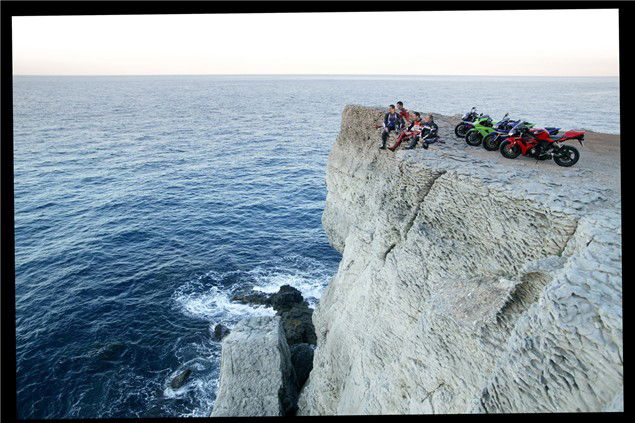
The French copper is looking confused. "Accident?" It's more of a question than a statement. His bemused gaze passes over the four brand new-looking bikes parked in front of a petrol pump. "There has been a crash?" Some fast-fingered motorist has obviously got on the blower and reported a bike sliding down the fast lane of the motorway. Our rozzer must have hurried to the scene expecting to find a tangled heap of metal.
Keen to avoid an extended interview with the authorities, I try to confuse him with a spot of bad French.
"No, non problem, Monsieur," I try, while still smiling, "C'est okay, bon." He seems pacified, if still a little baffled, and slips his blue and white Peugeot into gear and prepares to pull away.
Unfortunately it's at this point he spots the elbow of my jacket is worn away and the red leather suit underneath is poking out.
"You crash," he says. Definitely a statement now, not a question. "Yes," I say, "but only very slow, no problem," adding another nervous smile and a quick thumbs up for good measure. He may not be entirely satisifed but he scoots off anyway, no doubt reluctant to leave the warm and dry sanctuary of his car.
Only 400 miles or so into our mini-epic trip to Majorca and I've thrown a brand new Fireblade down the road. A schoolboy braking error on a very wet motorway locked the front wheel, precipitating a long and graceless slide. Considering the, um, speed at which all this occured - or at least began - the Fireblade came out well. When James Whitham himself describes your crash as 'spectacular' you know you've had a big one, but the Honda limped away with nothing more than minor scratches, a missing bar end and a neatly
polished engine case (thanks to the Emery paper-like effect of water and Tarmac ). No holes, not even a bent bar, and still rideable. While at this point its mega sharp front brake wasn't high on my list of likes about the Honda, the rest of it was really growing on me.
Even before we'd left the office the Honda had scored. Tail pack in hand I'd approached first the R1, then the GSX-R1000... not a chance of securing it to either (although somehow Tim managed it with his GSX-R1000 last year), so I tried the Blade. Bungee points and fantastic pillion pegs with cut-outs for bungee hooks made it easy. Top marks, Honda - practicality in a sportsbike, what next?
��
So off, then, to Majorca, where the roads are ace (according to James), the weather is good (according to the BBC), and off-season hotels are cheap ("They'd better be, or else," according to Grant). With the latest 1000cc sports tools at our disposal we'd be wasting our time in Blighty. It was easy to arrange a team: Whitham and his superstock racer mate Shoey were bang up for it. Tim was keen but dropped out at the last minute because he'd got a date, thus the multi-talented Warren Pole was persuaded to take a break from his voiceover work on Channel Five's Sex Lives of the Japanese.
Our plan involved a 600-mile London-to-Lyon slog on the first day. Should have been easy; thanks to rain and fuel range it wasn't.
Tim's got a measured approach to touring on sportsbikes that involves holding a steady speed and maximising every tank full. It's the stopping that kills your average speed, you see. Unfortunately Wozza, who we'd foolishly allowed to take the leadership mantle, has yet to grasp any part of this elementary concept.
"You're screwed," was Tim's gnomic verdict before we even set off. "Wozza rides like a complete twat. Don't let him lead."
As we discovered, Wozza's approach (summary: "You might as well enjoy the ride, so go really fast") doesn't hold up when you're cold, wet, 200 miles from where you want to be and stopping every 85 miles because you're burning fuel faster than an ACME jet pack.
Still, you learn things about the bikes; that they'll only do around 95 miles until reserve, even at a gentle(ish) pace, and that while none of them have fuel gauges, only the Yamaha has a genuinely useful fuel trip as well as a reserve light. The ZX-10R's new style instruments - digital speedo and analogue rev counter - are far clearer than the old all-digital set-up, but the flashing 'fuel' warning is just plain silly. You can see the fuel light's on, but because the trip display is taken up by the word 'fuel' you've no idea how far you've gone on reserve. Of course, on sportsbikes every kilo makes a difference, but since most of them will primarily be used on the road rather than on track, the longer-term practicality of having proper fuel gauges as standard would be worth the extra weight.
People say that you can't tour on sportsbikes, which is, quite frankly, utter twaddle. You can tour on any bike, it's just down to how much fun you have while doing it. The Lyon leg of our trip had been a nightmare. With only 450 miles to go and a dry dawn after a night's sleep (notwithstanding the faintly pissy waft of Lyon, somewhere between a tramp's pants and a Yeti's cock) even the regular fuel stops were something to look forward to.
"Yesterday I was wondering why the hell I was doing this," said James, "but this is mint. It's the first time I've done a big miles trip on sportsbikes and I'm loving it. Usually I ride them on track, which gives you one impression, but this really makes you think about the bikes. Before I wouldn't have recommended any of these for distance, but they're really good and even fairly comfortable."
Despite their sporting pedigree these bikes aren't uncomfortable over a distance. There were individual preferences: taller riders (that's myself and Wozza, both over six feet) liked the extra roominess of the Fireblade and ZX-10R while the 'vertically challenged' James and Shoey preferred the R1 and GSX-R1000.
"The seat is too big on the Kawasaki, I just slide all over it," said Shoey. "I just slot into the Suzuki; the seat seems lower and the whole bike is narrower, which helps me get my feet on the ground. The bars feel more race-like, too, which suits me."
James, being on the short side, was able to extract some shelter from the small screen on the Yamaha and take advantage of its lower pegs ("They feel like they're from a tourer compared with the others," he said). In the last big model change - when the underseat pipes came in - Yamaha moved the R1's pegs lower but also closer together, aiming to improving comfort without affecting ground clearance. But the screen's a bit low for tall riders.
Dry roads enabled the engines to show their character. Making a 'mere' 157.8bhp at the rear wheel, the Fireblade is actually the least powerful bike in this group, but Honda has done a neat trick.On paper there seems little different with the '06 Fireblade: slightly shorter wheelbase, redesigned fairing, engine tweaks and the rear sprocket up to 42 teeth from 40. The engine's only a few horsepower up but the sprocket change has made a massive difference. Last year's Blade was always criticised for lacking character. Somehow Honda had made 154bhp seem dull and slow. Well no more.
��
The 2006 Blade has some of the bite of the original. Accelerate in first and it now feels like a 1000cc bike should. The front pops up when the power kicks in at 8000rpm and there's a lovely vibration from the engine - enough to remind you it's a sportsbike without being intrusive or causing numb fingers.
Being used to the old Fireblade (I did over 10,000 miles on one before it was stolen... ) I kept finding myself having to check it was in top gear on the motorway because it felt so much more powerful than the old model in sixth gear acceleration. Okay, top speed is down around 10mph compared with the others, and fuel doesn't go as far as it did, but it's a small sacrifice for a better-feeling engine.
"It's very good, and very fast," said Wozza, "but I just find the others more exciting. The ZX-10R's engine is stunning. In the wet it would spin the rear wheel between 110 and 120mph, and the only way I could tell this was happening was the gentle rise and fall of the speedo. Having not ridden a fast bike for a while I was very impressed - and overawed - by it. The Blade is good, but the injection can be really abrupt going from a closed to slightly open throttle when you're trying to be smooth."
Both the Yamaha and Suzuki drew praise for their well-resolved fuel injection and general absence of throttle snatch.
"They're much better," said James, "especially the Suzuki. The GSX-R's engine is a gem - it feels loose, rattly and makes loads of noise, which I love, and it's really quick. Totally different to the Yamaha. The R1 feels refined. Still fast, but without any of the rattles of the Suzuki. Just smooth and fast. Ridiculously fast."
The real test would be when we reached the Majorcan bends. But that was tomorrow's job. Having got to Barcelona, and with the bikes 'secured' thanks to a piece of string handed to us by a stunningly unhelpful Majorcan ferryman, we crammed into a cabin and hoped for a smooth crossing. I assume that's what we got, because the bikes were all intact when we arrived, bleary eyed, in Palma.
Milking James's local knowledge, we aimed the bikes towards the coastal roads where their individual attributes could be assessed. After a few hours a few things became apparent. Firstly, the standard of driving in Majorca is terrible, bordering on appalling. Secondly, the roads are fantastic so long as the Tarmac is black (the brown stuff's super slippy, especially when wet). Thirdly, the ZX-10R's handling may be fantastic on track, but on the road it's way off the standard of the others. Back-to-back with the other three, the Kawasaki made everything hard work.
"This is awful," said James. "The inside bar need loads of input to get it to hold a line and if you back off it runs wide. It gets better if you're going balls out, but it isn't right. It feels too low at the back."
Having read launch reports about how fantastic the new ZX-10R is, I just couldn't believe it. I had to see for myself. But just a short ride confirmed that James was spot on. It felt like the steering damper was on maximum, and slow corners were a real effort.
"After the ride down I was very, very impressed with the ZX-10R," said Wozza, "until I rode the others and realised it doesn't go around corners. It feels like it has square head bearings. It's hard work to ride down twisty roads; it feels like a race bike. I bet on a track it would be awesome, but the slipper clutch is harsh on the road with loads of backlash and it needs to be forced everywhere. It's still a great engine but the chassis doesn't feel right."
It seems like Kawasaki has taken the old model, which handled brilliantly but was really lively on the road, and calmed it down too much. Its handling is now far less pleasing. In the balance of things it seems the ZX-10R has swung from too sharp to too blunt. The Fireblade, ironically, has been swinging the other way.
Last year's Blade was on the slow-steering side of things. It handled well, but lacked that razor sharpness of the GSX-R1000. With the shortened swingarm Honda has given the Blade some of this edge back. It still doesn't turn quite as fast as the Suzuki but is very close behind. On unfamiliar roads the Honda takes everything in its stride and never threatens to do anything un-expected. The quality of the suspension, especially the damping, is excellent and the revised motor helps it punch hard out of corners.
"It's lovely, this," cooed James, "it does everything properly, slow or fast corners. No fuss or bother, but it doesn't have quite the excitement of the Suzuki."
Last year we were all stunned that Suzuki could produce a bike as powerful as the GSX-R1000 that was so easy to control. And it still impresses. Okay, the competition has closed the gap, but the chassis on the Suzuki is still stunning. It's a cliché (though no less true for being repeated often enough to become one) but the GSX-R1000 really doesn't feel like a 1000cc bike, more of a rocket-charged 600. It provoked James to the edge of incoherence.
"It's a tiny, lovely little bike of niceness," he said. "Loads of power, but perfectly controlled. I didn't even notice the slipper clutch, which shows how good it was, and the chassis is sweet. I reckon it could nip you on the arse if you got too cocky, but it would let you know well before."
After two days riding around Majorca it was noticeable that one bike seldom cropped up in conversation: the R1. Each other bike had some special quality, curious tic or irritating flaw that could provoke lengthy debate.
With the ZX-10R it was the handling; with the Blade it was about how much better it was than last year's model; with the GSX-R, how it did everything well. The R1 was neither stunningly good or bad enough to work its way into the banter, a result of years of dedicated polishing by Yamaha's engineers.
"You forget just how good the R1 is," said James. "Every time I get on one I'm reminded, but then I forget again. It's so refined and controlled, not as sharp as the Honda or Suzuki, not as fast as the Kawasaki, but just good at everything. It feels like a street bike.
The others feel like they've been designed with races in mind, the Yamaha feels like it's been focused on the road."
"It's not that it lacks power," said Shoey, "it's just that it's not in your face like the Suzuki. It's disguised power."
"Power with a false nose, moustache and glasses," added Wozza. "Like Groucho Marx." It takes years of practice to be that observant.
After 2354 miles, covering all roads and conditions (with the possible exception of freezing fog, pack ice and snowdrifts, but you never know... ) there is one clear loser and two winners.
In the context of this test the Kawasaki lagged behind, chiefly because of its low speed manners. It has a great engine but the chassis is too track-focused to be enjoyable on the road. It would need work to sort out. As a pure track day tool it would be fantastic.
It may seem like a cop-out to have two winners but the jury was split. James and myself both agreed that our money would be with the Honda. It's got enough kick to make it exciting, has excellent and very reassured handling, and now has added fun. The Suzuki isn't far behind, if at all, but the Honda is just that bit easier. The Yamaha is still an excellent machine but against these bikes it just doesn't set our pulses racing in the way a 1000 should do. Wozza and Shoey, on the other hand, opted for the Suzuki.
Shoey, as a superstock racer, loved the aggression and power of the Suzuki while Wozza thought that the others wouldn't make him excited enough when he opened his garage door, while the Suzuki would. But he did get excited at finding an old jazz mag in a lay by.
As is usual, Whitham gets the final word: "Even if the Kawasaki was £1000 cheaper I wouldn't have it over the others. Otherwise, choose the cheapest or one you like the look of the most.You could pick the Honda, Suzuki or Yamaha and not be disappointed. "
��
